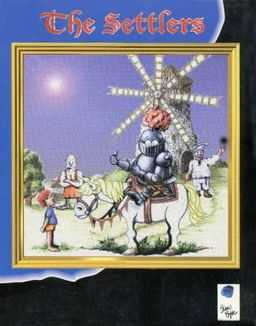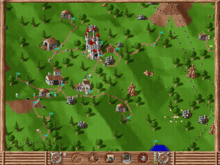The Settlers (video game)
| The Settlers | |
|---|---|
 | |
| Developer(s) | Blue Byte Software |
| Publisher(s) | Blue Byte Software |
| Designer(s) | Volker Wertich |
| Series | The Settlers |
| Platform(s) | Amiga, PC-DOS |
| Release date(s) | 1993 |
| Genre(s) | Real-time strategy |
| Mode(s) | Single player, multiplayer |
| Distribution | 3.5" disks (3) |
The Settlers (also known as Serf City: Life is Feudal, original German title Die Siedler) is a slow-paced strategy video game by Blue Byte Software, released in 1993 for Commodore Amiga and in 1994 for the PC.[1] The player is tasked with building a medieval settlement populated by an army of workers, each of whom perform their own individual task. The player competes against computer controlled opponents or another human player for supremacy of the land and resources.
Gameplay

Overview
The game offers a set of six tutorial games and a set of thirty predefined missions against computer controlled opponents of increasing difficulty. Alternatively, the player may opt to play a single open-ended game, for which the landscape is either randomly generated, or based on a seed number given by the player. The player can then freely choose up to three computer opponents of their choice. Additionally, a split-screen mode allows two human players to either team up together, or play against each other and up to two computer opponents. Finally, the player may instead allow up to four computer opponents to play against each other and spectate freely on their progress. There are ten computer characters, who vary from being peaceable and placid to being aggressive and warlike. Workers wear coloured shirts to identify their allegiance.
The game is controlled by a point-and-click interface. The player cannot directly control workers, but instead must place orders to construct buildings, manage the manufacture and distribution of goods and attack opponents. At the start of the game the player chooses the location of their castle, which houses the initial settlers and stock. The player must then construct buildings of various function to progress. Paths placed by the player enable transportation through the settlement. There are 24 kinds of building, 26 occupations and 26 kinds of material resources. Idle settlers are recruited to specialised roles when new buildings are completed. For example, a blacksmith appears once a smithy is constructed. The player also controls an army of knights, which is primarily used to defend the player's territory and to attack opponents. Normally, opponents can only be defeated and the game won by ensuring military, territorial and economic supremacy.
Construction and transportation
A key element is the placement of buildings and the layout of the road network to allow for efficient transportation. The end points of each path are marked by flags. With the exception of knights during battle, settlers must follow these paths. Only when completely cut off from their network (e.g. by enemy invasion) do workers wander aimlessly around. The game is designed in such a way that a worker (or item) will always travel the path with the shortest number of intersections to the destination, giving the player freedom to plan the distribution of goods. Goods move in a chain system, in which workers take goods from one flag to the next, and goods accumulate at flags (a maximum of eight items per flag); a priority system, which is adjustable by the player, dictates which goods are to be transported first. If placement of buildings and roads is not carefully planned it may lead to traffic congestion. If no counter action is taken (such as re-routing the goods, constructing new warehouses, better placement of buildings), such bottlenecks can have a distributed effect across the network, leading to delays and shortages or even causing defeat if reinforcements cannot get through.
Economy
The economy of the kingdom is also under the player's control. In game graphs and flowcharts allow the player to supervise the economic life of the kingdom and make adjustments to optimise production. Several food resources exist, and are necessary to feed miners, who dig for four materials: iron ore, gold ore, coal and stone. Two types of smelter will take one unit each of coal and gold or iron ore and produce ingots of gold or iron. Stone cutters cut from piles of stones that lie on the surface; once these are exhausted, stone must be mined. Woodsmen plant trees and woodcutters chop them down into logs. Logs are taken to the sawmill to be cut into planks. Iron and coal are required by the weaponsmith to make weapons, without which the knights cannot be armed. Simple buildings require only one plank and one stone; complex buildings may require more resources and time to complete. In cases where more than one profession competes for the same resource, the player may set the proportion each will receive. For example, the player may set which of the four types of miner receives food first, or what proportion of mined materials will be sent to the blacksmith or tool maker etc. The player may divert resources according to need; for example, once a stock of boats has been built, it is no longer necessary to waste planks by giving them to the boat builder. Some settlers require specific tools for their occupation. A toolmaker can manufacture additional tools from planks and iron, and the rate of manufacture of each tool is controlled by the player. While some resources such as trees and wheat are available in infinite supply, other resources will be exhausted over time. Players may attempt to cut off opponents from these resources, or invade their territory to capture them.
Military
The construction and occupation of a new military building expands the player's territory and an opponent's territory can be captured by defeat of enemy knights. Over time, with sufficient training the knights will be promoted in rank and better able in combat. Accumulation of gold bars improves the morale of knights and therefore military strength.
Design
Despite the appearance of rolling hills, all paths and game maps are built on a grid of overlapping hexagons, with flags and buildings positionable at the vertices. A regular hexagon denotes perfectly flat land, while pulling in the vertices gives the impression of steepness. On the largest map, the game can control a maximum of 65,536 individual settlers (due to the capacity of a 16-bit integer), all behaving autonomously.[2] Although small, the workers in the game are extremely detailed and cleverly animated. Each individual worker may be followed around by the player, and always acts in character. Workers may also be seen at work inside buildings.
As the player moves around the landscape the sounds of nearby settlers at work can be heard, alongside other ambient noises such as the tweeting of birds, the grunting of pigs, the yells of knights in battle, or the sound of wind in the mountains. The game also features medieval themed background music.
The pace of The Settlers is much slower than other games of this nature due to a variety of factors. The workers are constrained to move along paths specified by the user, as are the materials and resources. Some resources require lengthy processing chains before being useful to the player. Evidence of the slower pace can be seen in the statistical screens, which record a graph of the previous 50 hours of play, and a reminder to save the game being set at up to one hour. The slower paced game can potentially make time-dependent features longer to play out. Training knights to the highest levels or waiting for fishermen to catch fish may take a while.
Reception
Amiga Format rated the game at 94% in its 1993 Christmas issue, stating that it was "a major contender for the game of the year award."[2] CU Amiga awarded the game 90%.[3] Also in 1993, Amiga Power awarded the game 88% and in a 1996 roundup rated it the 25th best Amiga game of all time.[4][5] In 2011 Wirtualna Polska ranked it as the 17th best Amiga game.[6] In 2012, the Polish edition of CHIP ranked it as number one Amiga game.[7]
Serf City: Life is Feudal received 3 out of 5 stars in Dragon.[8]
Sequels
The series' original title in Germany is Die Siedler, marketed in the rest of Europe as The Settlers. When the game was first released in the United States, it was renamed Serf City: Life is Feudal by U.S. publisher SSI. However, starting with the second part in the series, The Settlers also became the official title of the series in the U.S.
- The Settlers (1993, Amiga & PC (DOS), aka Serf City: Life is Feudal)
- The Settlers II: Veni, Vidi, Vici (1996, PC (DOS), Macintosh)
- Add on: The Settlers II Mission CD
- Nintendo DS port (August 2007)[9][10]
- The Settlers III (1998, Windows)
- Add on: The Settlers III Mission CD
- Add on: The Settlers III: Quest Of The Amazons
- The Settlers IV (2001, Windows)
- Add on: The Settlers IV Mission CD
- Add on: The Settlers IV: The Trojans and the Elixir of Power
- Add on: Die Siedler IV: Die Neue Welt (The Settlers IV: The New World - only German language)
- Add on: Die Siedler IV: Große Feldzüge (The Settlers IV: Community Pack - only German language)
- Gameloft released a port of Settlers IV on the IPhone/IPod Touch App Store in November 2009.
- The Settlers: Heritage of Kings (Q4 Germany; 2005 Worldwide 2004, Windows), first sequel in 3D
- Add on: The Settlers: Heritage of Kings - Expansion Disk
- Add on: The Settlers: Heritage of Kings - Legends Expansion Disk
- The Settlers II 10th Anniversary (2006, Windows)
- Add on: The Settlers II: 10th Anniversary - The Vikings
- The Settlers: Rise of an Empire (2007, Windows)
- Add on: The Settlers: Rise of an Empire - The Eastern Realm (2008, Windows)
- The Settlers 7: Paths to a Kingdom (2010, Windows)[11]
Open source
Freeserf is an attempt to reimplement the game mechanics in C using the cross-platform SDL libraries. The game still requires the original game files to play.[12] Widelands is inspired by The Settlers, but creates a whole new game with its own free graphics.
References
- ↑ "Serf City: Life is Feudal". Moby Games. Retrieved 2006-11-05.
- ↑ 2.0 2.1 Mead, Rob (1993). "The Settlers". Amiga Format (Future Publishing) (54): 84–85. Retrieved 7 February 2013.
- ↑ Dillon, Tony (1993). "The Settlers". CU Amiga (EMAP): 178–179. Retrieved 7 February 2013.
- ↑ "The Settlers review". Amiga Power (Future Publishing) (32): 52–54. 1993. Retrieved 7 February 2013.
- ↑ "amiga Top 100". Amiga Power (Future Publishing) (64): 24. 1996. Retrieved 7 February 2013.
- ↑ (Polish) 16. The Settlers - 30 najlepszych gier na Amigę - Imperium gier, WP.PL (Polish)
- ↑ (Polish) Michał Wierzbicki, Dziesięć najlepszych gier na Amigę, Chip.pl, 23.02.2010
- ↑ Petersen, Sandy (September 1994). "Eye of the Monitor". Dragon (209): 61–62.
- ↑ GAME - The Settlers for DS
- ↑ GameSpot - The Settlers for DS. Retrieved July 23, 2007.
- ↑ Official Site for the 2010 Release of the Settlers VII: Path to a Kingdom. Retrieved January 26, 2010.
- ↑ Freeserf
External links
| ||||||||||